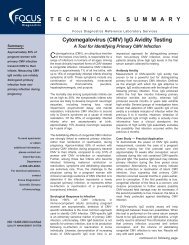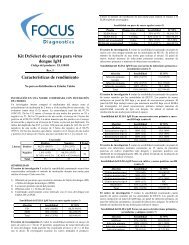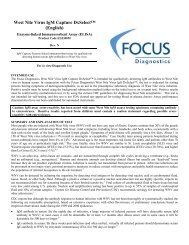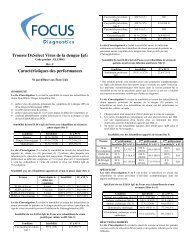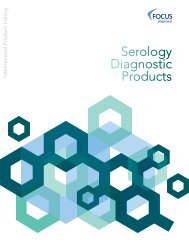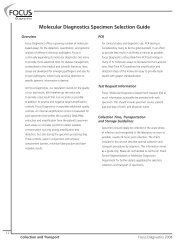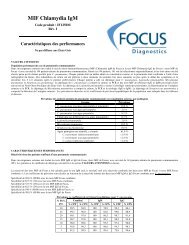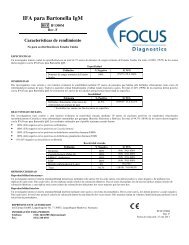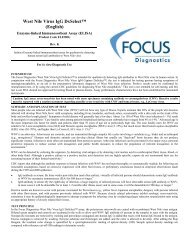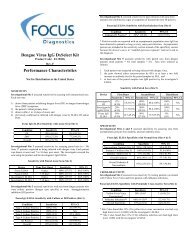Anaplasma phagocytophilum IFA IgM Kit Performance Characteristics
Anaplasma phagocytophilum IFA IgM Kit Performance Characteristics
Anaplasma phagocytophilum IFA IgM Kit Performance Characteristics
Create successful ePaper yourself
Turn your PDF publications into a flip-book with our unique Google optimized e-Paper software.
SPECIFICITY<strong>Anaplasma</strong> <strong>phagocytophilum</strong><strong>IFA</strong> <strong>IgM</strong> <strong>Kit</strong>Product Code: IF1450MRev. C<strong>Performance</strong> <strong>Characteristics</strong>Not for Distribution in the United StatesTwo external investigators and an internal investigatorevaluated specificity with a total of 85 sera: 60 sera from nonendemicareas and 25 sera from an endemic area. All serawere from unexposed blood donors. The Focus <strong>Anaplasma</strong><strong>phagocytophilum</strong> <strong>IFA</strong> <strong>IgM</strong> was negative with 100% (45/45)of the endemic and non-endemic European sera. Of the nonendemicU.S. sera, the Focus <strong>Anaplasma</strong> <strong>phagocytophilum</strong><strong>IFA</strong> <strong>IgM</strong> was negative with 97.5% (39/40).Specificity with Blood DonorsPopulation % Negative 95% CIEndemic (Slovenia) 100% (25/25)†86.3-100%Non-endemic (France) 100% (20/20)83.2-100%Non-endemic (U.S.) 97.5% (39/40)86.8-99.9%† One sample scored negative did have some non-specific reactivity.% Negative1009590Specificity with Blood DonorsEndemic (Slovenia)Non-endemic(France)Non-endemic(California)SENSITIVITYSensitivity with PCR/Blood Smear Positives by TimeAn external investigator evaluated sensitivity using thirty serafrom fifteen patients that were diagnosed with <strong>Anaplasma</strong><strong>phagocytophilum</strong> infections. <strong>Anaplasma</strong> <strong>phagocytophilum</strong>infection was diagnosed based on the following criteria:1) acute febrile illness, and2) Ixodes species tick bite in an endemic area, and3) laboratory confirmed (positive by PCR and/or bloodsmear).The PCR was specific for 16S rDNA of <strong>Anaplasma</strong><strong>phagocytophilum</strong>, and was described by Chen, et al. 1 Bloodsmears were positive if intracytoplasmic morulae wereidentified in blood, bone marrow, or CSF. Sensitivity wasstratified based on days after onset of symptoms. Of the thirtysamples, 14 were drawn less than 60 days after symptomonset, 13 were drawn greater than 60 days, and three weredrawn an unknown number of days after symptom onset. TheFocus <strong>Anaplasma</strong> <strong>phagocytophilum</strong> <strong>IFA</strong> <strong>IgM</strong> had thefollowing sensitivity:Less than 60 days: of the fourteen drawn less than 60 daysafter symptom onset, 71.4% (10/14) were positive.More than 60 days: of the thirteen drawn more than 60 daysafter symptom onset, 7.7% (1/13) were positive.Unknown: of the three sera drawn at an unknown number ofdays after symptom onset, 100.0% (3/3) were positive.Sensitivity with PCR/Blood Smear Positives by TimeTime after Symptom Onset % Positive 95% CILess than 60 days 71.4% (10/14)41.9-91.6%More than 60 days 7.7% (1/13)0.2-36.0%Unknown 100.0% (3/3)29.2-100%% Positive806040200Sensitivity with PCR/Blood Smear PositivesLess than 60 daysMore than 60 daysTime after Onset of SymptomsSensitivity with Paired SeraAn external investigator evaluated sensitivity using 15 pairs ofsera drawn at least two weeks apart from 15 patients that werediagnosed with <strong>Anaplasma</strong> <strong>phagocytophilum</strong> infections.<strong>Anaplasma</strong> <strong>phagocytophilum</strong> infection was diagnosed basedon the following criteria:
FOCUS Diagnostics1) clinical symptoms compatible with <strong>Anaplasma</strong><strong>phagocytophilum</strong> infection and2) a four-fold or greater change in the investigator's inhouse<strong>Anaplasma</strong> <strong>phagocytophilum</strong> <strong>IFA</strong> IgG titer.The clinical symptoms included febrile illness, history of tickbite, leukopenia and thrombocytopenia and/or elevatedhepatic transaminase. The investigator's in-house IgG <strong>IFA</strong> waspreviously described by Nicholson, et al. 2 Of the 15 pairs ofsera, 11 pairs demonstrated a four-fold rise with theinvestigator's in-house IgG <strong>IFA</strong> (acute), and four pairsdemonstrated a four-fold fall in the investigator's in-house IgG<strong>IFA</strong> (convalescent). Of the 11 pairs demonstrating a four-foldrise, the Focus <strong>Anaplasma</strong> <strong>phagocytophilum</strong> <strong>IFA</strong> <strong>IgM</strong> waspositive for 9.1% (1/11) with the first draws, and 72.7%(8/11) with the second draws. Of the four pairs demonstratinga four-fold fall in the investigator's in-house <strong>IFA</strong>, the Focus<strong>Anaplasma</strong> <strong>phagocytophilum</strong> <strong>IFA</strong> <strong>IgM</strong> was positive withnone of the first draws and none of the second draws.% Positive806040200Sensitivity with Paired SeraInvestigator'sIgG <strong>IFA</strong>1st Draw 2nd Draw% Positive 95% CI % Positive 95% CI9.1% (1/11) 72.7% (8/11)0.2-41.3%39.0-94.0%RisingIgGFallingIgG0.0% (0/4)0.0-60.2%0.0% (0/4)0.0-60.2%CROSS-REACTIVITYTwo external investigators evaluated cross-reactivity byselecting sera from patients that were symptomatic for andsero-positive for the potential cross-reactant.Cross-reactivityCross-reactant % Positive 95% CITickborne Encephalitis 0.0% (0/15)0.0-21.8%Mediteranean Spotted Fever(Rickettsi conorii)0.0% (0/25)0.0-13.7%Acute Q Fever (Coxiellaburnetii)0.0% (0/10)0.0-30.8%Lyme Borreliosis (Borrelia 0.0% (0/36)burgdorferi) **Bartonella quintanaEndocarditisSensitivity with Paired Sera1st Draw2nd Draw0.0-9.7%0.0% (0/10)0.0-41.0%** Co-infection with both Borrelia burgdorferi and <strong>Anaplasma</strong><strong>phagocytophilum</strong> have been reported. 3STABILITY<strong>Anaplasma</strong> <strong>phagocytophilum</strong> <strong>IFA</strong> <strong>IgM</strong>Page 2An internal investigator evaluated stability. Components wereaccelerated to a 2 to 8C equivalent of one and two years.The accelerated components were then tested according to thepackage insert in parallel with unaccelerated components.Components are considered stable if they meet the QC criteriaspecified in the package insert. The product was found stableafter accelerating for both one and two years.REPRODUCIBILITYIntra-assay and Inter-assay ReproducibilityAn internal investigator evaluated intra-assay and inter-assayreproducibility. Ten patient sera were run on three separateslides each day over five days (n = 150). Four sera werepositive, one was borderline and five sera were negative.Results for all sera were within one two-fold dilution.Inter-lot ReproducibilityAn internal investigator evaluated inter-lot reproducibility.Ten patient sera were run on three lots of slides (n = 30). Foursera were positive, one was borderline and five sera werenegative. Results for all sera were within one two-folddilution.REFERENCES1. Chen S-M, Dumler JS, Bakken JS, Walker DH. Identification of aGranulocyto tropic Ehrlichia Species as the Etiological Agent of HumanDisease. J Clin Micro 1994; 32: 589-595.2. Nicholson WL, Comer JA, Sumner JW, et al. An indirectimmunofluorescence assay using a cell culture-derived antigen fordetection of antibodies to the agent of human granulocytic ehrlichiosis. JClin Microbiol 1997; 35: 1510-16.3. Nedelman, RB et al. Simultaneous Human Granulocytic Ehrlichiosis andLyme Borrleiosis. N Engl J Med 1997;337:27-30.ORDERING INFORMATIONTelephone: (562) 240-6500 (International)Fax: (562) 240-6510TECHNICAL ASSISTANCETelephone: (562) 240-6500 (International)Fax: (562) 240-6526AUTHORIZED REPRESENTATIVEmdi Europa GmbHLangenhagener Str. 71,30855 Langenhagen-Hannover, GermanyVisit our web site at: www.focusdx.comCypress, California 90630 U.S.A.PC.IF1450MRev. CDate written: 27 Jan 2011



